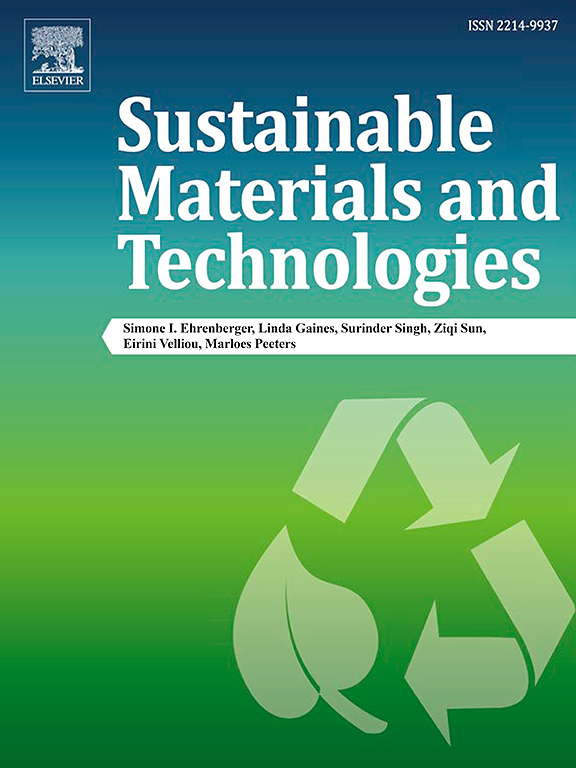芒果叶提取物作为盐酸介质中 X70 钢的可持续缓蚀剂:综合实验分析和电子/原子尺度计算模拟
IF 8.6
2区 工程技术
Q1 ENERGY & FUELS
引用次数: 0
摘要
芒果是大多数国家最丰富的果树作物之一。遗憾的是,由于芒果叶产量丰富,通常被作为农业废弃物倾倒,造成了严重的浪费和环境污染。本研究利用电化学和失重技术研究了芒果叶提取物(MLE)在 1 M HCl 中对 X70 钢腐蚀的抑制机制。结果表明,芒果叶提取物是 X70 钢在酸性环境中抗腐蚀的极佳缓蚀剂,通过增加缓蚀剂浓度和降低温度可有效提高缓蚀效率。电化学测试表明,MLE 是一种具有混合型机理的缓蚀剂。将吸附等温线与电化学数据拟合,证实了 MLE 通过吸附作用在金属表面表现出耐腐蚀性,且这种吸附符合 Langmuir 等温线。利用原子力显微镜(AFM)和扫描电子显微镜(SEM)对吸附现象进行了深入研究。进一步证明了 MLE 能与钢表面相互作用生成吸附层,从而防止钢在酸性环境中腐蚀。其中,密度函数紧密结合(DFTB)计算结果还表明,MLE 主要成分中的π电子和孤对电子有利于增强缓蚀剂分子在铁表面的吸附,从而达到更有效的缓蚀效果。此外,毒性预测表明 MLE 成分几乎无毒,符合环保法规。MLE 具有优异的耐腐蚀性,在浓度为 400 mg/L 时,缓蚀效率接近 90%,同时还有助于解决农业废弃物管理难题。本文章由计算机程序翻译,如有差异,请以英文原文为准。

Mango leaves extract as sustainable corrosion inhibitor for X70 steel in HCl medium: Integrated experimental analysis and computational electronic/atomic-scale simulation
Mangoes are one of the most abundant fruit tree crops in most countries. Unfortunately, mango leaves are generally dumped as agricultural waste due to their abundance, resulting in significant waste and environmental pollution. In this study, electrochemical and weight loss techniques were utilized to investigate the inhibitory mechanism of mango leaves extract (MLE) on the corrosion of X70 steel in 1 M HCl. The results indicated that MLE was an excellent corrosion inhibitor for X70 steel to resist corrosion in an acidic environment, and the inhibition efficiency was effectively improved by increasing the inhibitor concentration and decreasing the temperature. Electrochemical tests have shown that MLE functions as a corrosion inhibitor with a mixed-type mechanism. Fitting the adsorption isotherm with electrochemical data, confirmed that MLE demonstrates corrosion resistance on metal surfaces through adsorption, and this adsorption conforms to the Langmuir isotherm. The adsorption phenomenon was deeply investigated by using atomic force microscopy (AFM) and scanning electron microscopy (SEM). MLE is further proven to interact with the steel surface to generate an adsorption layer that prevents steel corrosion in an acidic environment. In particular, the density-functional tight-binding (DFTB) calculations results also suggest that the π electron and lone-pair electrons in the main components of MLE are conducive to enhancing the adsorption of corrosion inhibitor molecules on the iron surface, to achieve a more effective inhibition effect. Furthermore, the toxicity prediction indicates that the MLE components are nearly non-toxic, which complies with environmental protection regulations. MLE has excellent corrosion resistance, with a corrosion inhibition efficiency of nearly 90 % at a concentration of 400 mg/L, while also helping to solve agricultural waste management challenges.
求助全文
通过发布文献求助,成功后即可免费获取论文全文。
去求助
来源期刊

Sustainable Materials and Technologies
Energy-Renewable Energy, Sustainability and the Environment
CiteScore
13.40
自引率
4.20%
发文量
158
审稿时长
45 days
期刊介绍:
Sustainable Materials and Technologies (SM&T), an international, cross-disciplinary, fully open access journal published by Elsevier, focuses on original full-length research articles and reviews. It covers applied or fundamental science of nano-, micro-, meso-, and macro-scale aspects of materials and technologies for sustainable development. SM&T gives special attention to contributions that bridge the knowledge gap between materials and system designs.
 求助内容:
求助内容: 应助结果提醒方式:
应助结果提醒方式:


